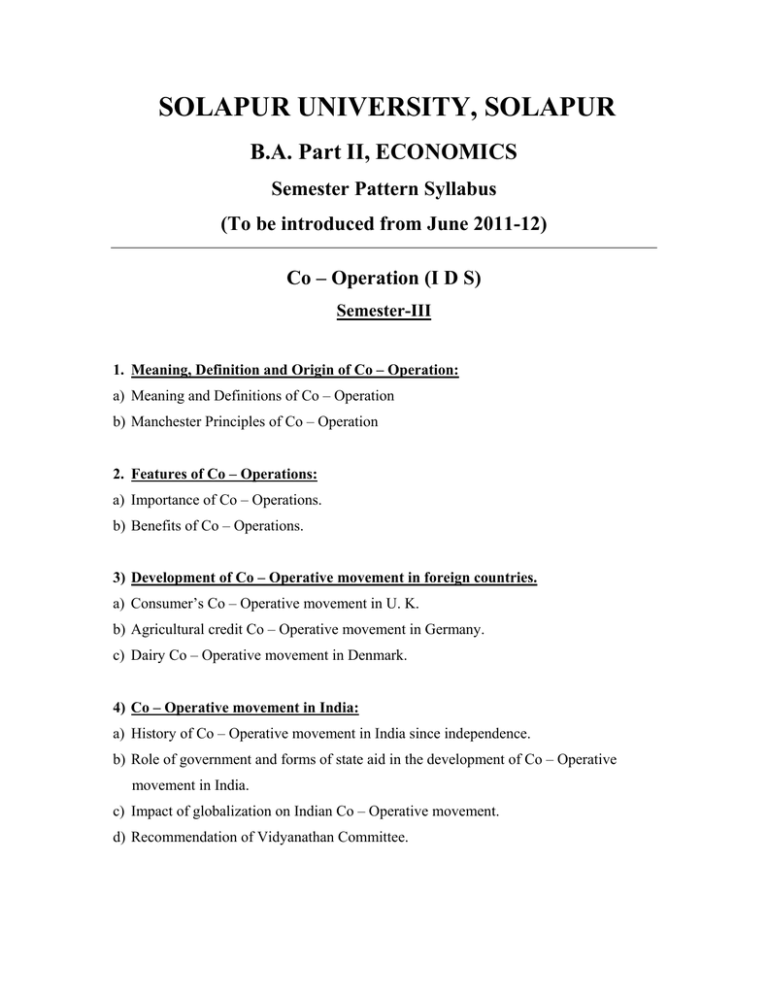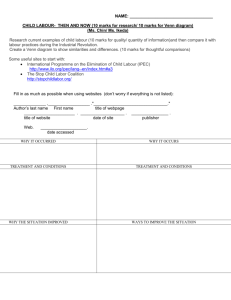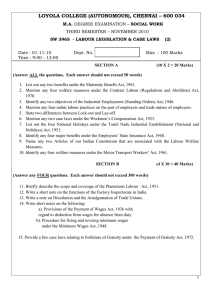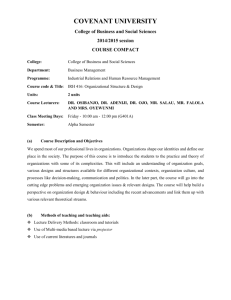SOLAPUR UNIVERSITY, SOLAPUR B.A. Part II, ECONOMICS Semester Pattern Syllabus
advertisement

SOLAPUR UNIVERSITY, SOLAPUR B.A. Part II, ECONOMICS Semester Pattern Syllabus (To be introduced from June 2011-12) Co – Operation (I D S) Semester-III 1. Meaning, Definition and Origin of Co – Operation: a) Meaning and Definitions of Co – Operation b) Manchester Principles of Co – Operation 2. Features of Co – Operations: a) Importance of Co – Operations. b) Benefits of Co – Operations. 3) Development of Co – Operative movement in foreign countries. a) Consumer’s Co – Operative movement in U. K. b) Agricultural credit Co – Operative movement in Germany. c) Dairy Co – Operative movement in Denmark. 4) Co – Operative movement in India: a) History of Co – Operative movement in India since independence. b) Role of government and forms of state aid in the development of Co – Operative movement in India. c) Impact of globalization on Indian Co – Operative movement. d) Recommendation of Vidyanathan Committee. Basic Reference List 1. Principles, Problems and Practice of co – operation.- Hajela T. N. 2. Theory, History and Practice of co-operation – Bedi R. D. 3. Co-operation in India. – Mamoria-Saksena. 4. Co-operative Sector in India. – Sami Uddin – Mahfoozur Rahman. 5. Co-operatives in the new million. – R. Salvaraju. 6. The theory of co-operation - V. Sharda 7. Co-operation in India – Mathur B. S. 8. Recent Trends in the co-operative movementin India.- Tyagi R. B. 9. ÃÖÆüúÖ¸ü - ¿ÖÆüÖ/¤üÖ´Ö•Öß 10.ÃÖÆüúÖ¸üÖ“ÖÖ ×¾ÖúÖÃÖ - ¿ÖÆüÖ/¤üÖ´Ö•Öß 11. ÃÖÆüúÖ¸ü : ŸÖŸ¾Öê ¾Ö ¾μÖ¾ÖÆüÖ¸ü - ¸üÖμÖÖê»Öú¸ü/›üÖÓÖê 12. ÃÖÆüúÖ¸ü - ³ÖÖêÃÖ»Öê/úÖ™êü 13. ÃÖÆüúÖ¸ü : ŸÖŸ¾Öê , ¾μÖ¾ÖÆüÖ¸ü †ÖÖß ¾μÖ¾ÖãÖÖ¯Ö−Ö - ÖÖê. ÃÖ. úÖ´ÖŸÖ Semester-IV 1) Role of National Agencies and Organizations in the development of Co – operative movement: a) National Bank for Agricultural and Rural Development. b) National Co – Operative Development Corporation. c) National Co – Operative Union of India. 2) Development, Present position and problems of Co–operative credit in India: a) Primary Agricultural credit Co – operatives. b) District central Co – operative Banks c) State Co – operative Banks. d) Urban Co – operative Banks. 3) Development, present position and problems of following non–credit Co-operatives in Maharashtra: a) Sugar co – operatives b) Marketing co – operatives c) Dairy co – operatives 4) Broad features of Maharashtra co – operative societies Act (1960) in respect of: a) Registration and Membership b) Annual general meeting c) Maintenance of Accounts and Audit. Basic Reference List 1. Co-operation in India – Bhatnagar and others. 2. A Study in the co-operation in India – Iyengar. 3. New Dimensions of co-operative Management – Kamat G.S. 4. Principles, Problems and Practice of co-operation – Hejela T.H. 5. Theory, History and Practice of co-operation - Bedi R.D. 6. Co-operation in India – Mamoria – Saksena 7. The theory of co-operation V.Sharda 8. Co-operation in India – Mathur B.S. 9. Law and management of co-operatives – Trivedi, B.B. 10. ÃÖÆüúÖ¸ü - ¿ÖÆüÖ/¤üÖ´Ö•Öß 11. ÃÖÆüúÖ¸üÖ“ÖÖ ×¾ÖúÖÃÖ - ¿ÖÆüÖ/¤üÖ´Ö•Öß 12. ÃÖÆüúÖ¸ü : ŸÖŸ¾Öê ¾μÖ¾ÖÆüÖ¸ü - ¸üÖμÖÖê»Öú¸ü/›üÖÓÖê 13. ÃÖÆüúÖ¸ü - ³ÖÖêÃÖ»Öê/úÖ™êü 14. ÃÖÆüúÖ¸ü : ŸÖŸ¾Öê, ¾μÖ¾ÖÆüÖ¸ü †ÖÖß ¾μÖ¾ÖãÖÖ¯Ö−Ö 15. ÃÖÆüúÖ¸üÖ“Öß ´Öæ»ÖŸÖŸ¾Öê - ¯ÖÏ. ¸üÖ. ãú»ÖúüÖá - ÖÖê. ÃÖ. úÖ´ÖŸÖ SOLAPUR UNIVERSITY, SOLAPUR B.A. Part II, ECONOMICS Semester Pattern Syllabus (To be introduced from June 2011-12) Labour Welfare (I.D.S.) Semester-III 1) Labour Welfare 1.1.Concept-definition, scope, objectives and importance. 1.2.Welfare work and Social work. 2) Origin and Development of Labour Welfare. 2.1. Evolution of Labour Welfare 2.2. Development of Labour welfare in U. K. and India. 3) Labour Problems 3.1. Meaning of Labour problem and it’s classification. 3.2 Labour problems in India. 3.2.1.Problems of Unemployment. 3.2.2.Problem of child and women labours. 3.2.3.Measures to solve labour problems in India. 4) Labour Market : 4.1. Concept and Definition. 4.2. Types of Wage Differentials. 4.3. Causes of Difference in Wages. 4.4. Wage Differential in India. Books for Reference 1) Bhagoliwal T. N.: Economics of Labour and Social Welfare 2) Saxena R. C. :Labour problems and Social Welfare 3) Mamoria C. B.and Doshi S. L.: Labour problems and Social Welfare 4) Mamoria C. B.:Social problems in India. 5) ›üÖò. ±ú›ü¾ÖÖßÃÖ/ ›üÖò. ¯ÖÏÖ“Öß ¤êü¿Ö¯ÖÖÓ›êü - ÁÖ´Ö†£ÖÔ¿ÖÖÃ¡Ö 6) ¤êü¿Ö´ÖãÖ ¯ÖϳÖÖú¸ü - ÁÖ´Ö†£ÖÔ¿ÖÖÃ¡Ö 7) −Öê¸üú¸ü פü»Öß¯Ö - ÁÖ´Ö†£ÖÔ¿ÖÖÃ¡Ö 8) ÖÖêÖ»Öê ‹ÃÖ.›üß. - úÖ´ÖÖÖ¸ü ú»μÖÖÖ Semester - IV 1) Labour Welfare Agencies: 1.1. Government, employers, trade Unions, I.L.O. 1.2. Labour efficiency – meaning, measurement, factors determining efficiency of labour. 2) Welfare provision of labour legislation in India: 2.1 Factories Act- 1952. 2.2. Bonus Act-1965. 3) Social Security: 3.1. Definition, Objectives, Scope. 3.2. Social insurance and Social assistance. 4) Social Security legislation in India: 4.1.Worker’s Compensation Act – 1923 4.2. Employers State Insurance Act – 1948 4.3. Employers Provident Fund Act – 1952 4.4. Maternity benefit Act – 1961 Books for Reference 1) Bhagoliwal T. N.: Economics of Labour and Social Welfare 2) Saxena R. C. :Labour problems and Social Welfare 3) Mamoria C. B.and Doshi S. L.: Labour problems and Social Welfare 4) Mamoria C. B.:Social problems in India. 5) ›üÖò. ±ú›ü¾ÖÖßÃÖ/ ›üÖò. ¯ÖÏÖ“Öß ¤êü¿Ö¯ÖÖÓ›êü - ÁÖ´Ö†£ÖÔ¿ÖÖÃ¡Ö 6) ¤êü¿Ö´ÖãÖ ¯ÖϳÖÖú¸ü - ÁÖ´Ö†£ÖÔ¿ÖÖÃ¡Ö 7) −Öê¸üú¸ü פü»Öß¯Ö - ÁÖ´Ö†£ÖÔ¿ÖÖÃ¡Ö 8) ÖÖêÖ»Öê ‹ÃÖ.›üß. - úÖ´ÖÖÖ¸ü ú»μÖÖÖ SOLAPUR UNIVERSITY, SOLAPUR B.A. Part II, ECONOMICS Semester Pattern Syllabus (To be introduced from June 2011-12) Paper II Money, Banking and Public Finance Semester – III 1. Basic Concepts 1.1. Money-meaning, evolution of money. 1.2. Functions and classification. 2. Value of money and inflation 2.1. Value of money, price index (Simple and weighted) 2.2. Quantity Theory of money, Cash Transaction and Cash Balance approach. 2.3. Inflation – meaning types, causes and effects, measures to control it. 3. Commercial Banking 3.1. Definition – Functions. 3.2. Process of Credit Creation and it’s Limitaiton. 3.3. Priniciples of Banking – Liquidity, Profitability and safety. 3.4. Recent Reforms in Banking Sector in India. 3.5. Concepts of ATM, Debit Card, Credit Card, E-Banking. 4. Central Banking 4.1. Definition and functions. 4.2. Methods of credit control. 4.3. Role and Functions of R.B.I. since 1991. List of Reference Book 1) Gupta S.B. Monetary Economics, S. Chand and Company, New Delhi. 2) Ackley G. Macro Economics. 3) Mithani D.M. - Money Banking. 4) De-cock M.H. - Central Banking. 5) ¯ÖÏÖ.›üÖò. ãú¹ý»Öú¸ü ¸ü. ¯Öã. ²ÖòØúÖŸÖŸ¾Öê, †Ö×Ö ²ÖòØúÖ ¯Ö¬¤üŸÖß. 6) ¤êüÃÖÖ‡Ô , •ÖÖê¿Öß - †ÖÙ£Öú ×¾Ö¿»ÖêÂÖÖ ³ÖÖÖ-2, úÖÑ™üßê−Öê™ü»Ö ¯ÖÏúÖ¿Ö−Ö. 7) .L. Seth - Macro Economics. 8) K.P.M .Sundarom - Prinicples of Economics. Semester -IV 1. Public Finance 1.1. Meaning, Distinction between public finance and private finance. 1.2. Principles of maximum Social Advantage.(Dr. Dalton’s Approch) 2. Public expenditure 2.1. Meaning and principles of public expenditure. 2.2. Causes of growth in public expenditure in India. 3. Taxation 3.1. Meaning, canons and classification. 3.2. Burden of tax, Benefit and Ability to pay approach Concept of Impact, shitting and incidence of tax burden. 3.3. Taxable Capacity – Concepts, factors determining taxable Capacity. 3.4. Major Trends in Tax revenue of the central Government of India since 2001. 4. Public debt and Financial Administration 4.1. Meaning, Sources of public debt. 4.2. Effects of public debt. 4.3. Growth of India’s public debt. 4.4. Public Budget- Meaning and kinds. List of Reference Books 1) M.L. Seth : Macro Economics 2) K. P.M. Sundaram : Prinicples of Economics 3) B.P. Tyagi : Public Fiance SOLAPUR UNIVERSITY, SOLAPUR B.A. Part II, ECONOMICS Semester Pattern Syllabus (To be introduced from June 2011-12) Paper No. III DEMOGRAPHY Semester -III 1. Population Studies a) Demography – Concepts, Definitions, Nature Scope and Importance. b) Post Independence developments of population studies in India. c) Inter – relationship between population studies and other disciplines. 2. Sources of Demography Data in India a) Population- census b) Civil registration System. c) Demographic Surveys. d) Merits and Demerits of Sources of population data. 3. Theories of population a) Malthusien Theory b) Optimum Population Theory c) Theory of Demographic Translation. 4. Techniques of Analysis a) Birth and Death Rates, Crude Birth and Death rates, Age Specific Birth and Death rates, standardized Birth and Death Rates. b) Study of Fertility: Total fertility Rate. Gross Reproduction Rate, Net Reproduction rate. Semester -IV 1. Migration Meaning, Causes and types. 2. Population Studies and characterstics of population in India since 1951 a) Size and Growth of population b) Sex Structure (Recent Issues) c) Age Structure d) Literacy e) Occupational Structure 3. Population Policy in India a) Evolution of population policy in India. b) Shift in policy focus from population control to family welfare and to women empowerment. c) Education, women’s Autonomy and Fertility. d) Population, Health, Poverty and Environment Linkages in India. e) The New population policy. 4. Population Projection and Forecasting Techniques a) Measurement of Growth Rates : Simple and Compound growth Rate b) Time Series Analysis c) Forecasting Reference Books 1. India’s Population Problems: Agrawal S.N. & Sinha U.P. 2. Principles of population studies - Bhende Asha, A. Kanitkar Tara 3. Demography – Jhingan, Bhatt & Desai. 4. Population Policy in India- Gandolra & Narayan Das. 5. Population Settlement Development and planning. – Lal K. M. 6. Fundamentals of Demography – Han. Raj. 7. Techniques of Demographic Analysis.- Pathak K. B.& Ram F. 8. Demography- Ptel R. Lox. 9. A Text Basic Demography- Shrivastava O.S. 10. Census of India- Govt. of India- Rparts 11. Principles of population studies.-Mrs. Bhonde and Kantkar. 12. Population Projections and their Accuracy- Agrawal U.D. 13. Fertility in India - Gulati S.C. 14. »ÖÖêúÃÖÓμÖÖ - †×™ü¸ü¸üÖ¾Ö ¾Ö ‡ŸÖ¸ü 15. »ÖÖêúÃÖÓμÖÖ - ÃÖÖî úÖ×−Ö™üú¸ü ŸÖÖ¸üÖ ¾Ö ÃÖÖî ÃÖã´ÖŸÖß ãú»ÖúÖá 16. »ÖÖêúÃÖÓμÖÖ - ³ÖÖêÃÖ»Öê - úÖ™êü 17. •Ö−ÖÃÖÓμÖÖ¿ÖÖÃ¡Ö - ÆãÓü›êüú¸ü, ¿ÖÆüÖ, ú¤ü´Ö 18. ³ÖÖ¸üŸÖßμÖ †£ÖÔ¾μÖ¾ÖãÖÖ - ³ÖÖêÃÖ»Öê - úÖ™êü Solapur University, Solapur Nature of Question Paper For Semester Pattern • Faculty of Social Science (UG/PG Courses) (w.e.f. June 2011) Time - 2 Hours Total Marks– 50 Marks Instruction – (1) All questions are Compulsory. (2) Figures to the Rights indicate full marks. Q. 1) Multiple choice questions (Ten) 10 Marks (With four alternatives) Q. 2) Write short Answer of the following 08 Marks (Any four out of six) Q. 3) Write short notes 12 Marks (Any four out of six) Q. 4) Answer any one long type question of the following A OR 10 Marks B Q. 5) Long answer type question 10 Marks 1. Structure of the courses :A) Each paper of every subject for Arts, Social Sciences & Commerce Faculty shall be of 50 marks as resolved by the respective faculties and Academic Council. B) For Science Faculty subjects each paper shall be of 50 marks and practical for every subject shall be of 50 Marks as resolved in the faculty and Academic Council. C) For B. Pharmacy also the paper shall be of 50 marks for University examination. Internal marks will be given in the form of grades. D) For courses which were in semester pattern will have their original distribution already of marks for each paper. E) For the faculties of Education, Law, Engineering the course structure shall be as per the resolutions of the respective faculties and Academic Council. 2. Nature of question paper: A) Nature of questions. B) C) D) 3. 4. “20% Marks - objectives question” (One mark each and multiple choice questions) “40% Marks - Short notes / Short answer type questions / Short Mathematical type questions / Problems. (2 to 5 Marks each) “40% Marks - Descriptive type questions / Long Mathematical type questions / Problems. (6 to 10 Marks each) Objective type question will be of multiple choice (MCQ) with four alternatives. This answer book will be collected in first 15 minutes for 10 marks and in first 30 minutes for 20 marks. Each objective question will carry one mark each. Questions on any topic may be set in any type of question. All questions should be set in such a way that there should be permutation and combination of questions on all topics from the syllabus. As far as possible it should cover entire syllabus. There will be only five questions in the question paper. All questions will be compulsory. There will be internal option (40%) and not overall option. for questions 2 to 5. Practical Examination for B. Sc. I. will be conducted at the end of second semester. Examination fees for semester Examination will be decided in the Board of Examinations. The structures of all courses in all Faculties were approved and placed before the Academic Council. After considered deliberations and discussion it was decided not to convene a meeting of the Academic Council for the same matter as there is no deviation from any decision taken by Faculties and Academic Council. Nature of Question Paper approved by Hon. Vice Chancellor on behalf of the Academic Council.






